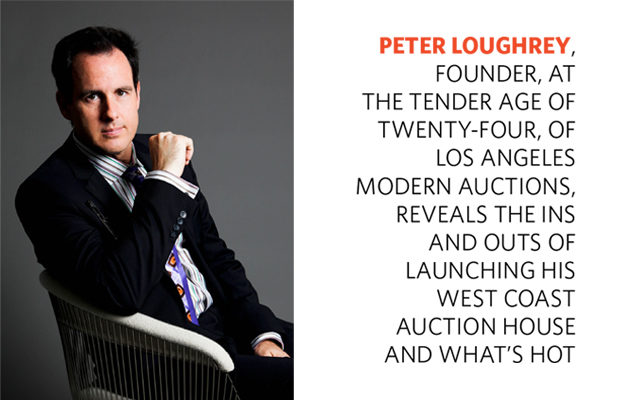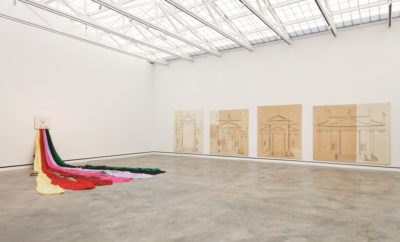 LOS ANGELES MODERN AUCTIONS PHOTOS
LOS ANGELES MODERN AUCTIONS PHOTOS
Design
Launching LAMA: Los Angeles Modern Auctions
BACK IN THE EIGHTEENTH CENTURY when Thomas Chippendale and George Hepplewhite (among others) reigned, Christie’s, Sotheby’s, and Phillips were already in the auction business. Peter Loughrey jump-started Los Angeles Modern Auctions (LAMA), now celebrating its twentieth anniversary season, not so long ago—1992. It is a bit of an anomaly on several fronts.
For starters, Loughrey, now forty-four, opened LAMA when he was only twenty-four. He first conceived the idea of the auction house in 1991 while in London bidding on modern design at Bonhams. There, many of the items were under £100 and the salesroom was packed with the younger set. He believed Los Angeles could support a similar venture—an accessible auction house for reasonably priced design. Back in Los Angeles, he held his first auction in 1992 and then decided to enroll in the Sotheby’s Works of Art course in London. “I wanted to learn how the big guys had been doing it for over two hundred years,” he says.
Loughrey had started out in 1988 as a picker for his brother’s antiques business in Los Angeles. He trolled thrift stores and estate sales looking for all manner of twentieth-century American design and zeroed in on jukeboxes, chrome toasters, brightly enameled kitchen appliances (Sunbeam Mixmasters were a favorite), and bowling balls that sported a vintage look. The following year, he and his brother opened a shop on La Brea called Bedrock Gallery that featured mid-century modern and industrial design. “This was a mission statement of sorts,” Loughrey says, the name intended to “infer that you could start a collection of twentieth-century design here but also a sly reference to The Flintstones, which we felt every baby boomer would get.” That shop morphed into LAMA.
Talk about stratospheric growth: Loughrey hammered down $99,000 his first year. By 2012 his total sales tipped over the $8 million mark. He routinely reaps records for Charles and Ray Eames, George Nakashima, and Sam Maloof, to name just a few.
MODERN Magazine tapped Loughrey to learn the details of LAMA’s amazing growth, the current market shifts, and the finer points of West Coast design.
Can you explain why founding LAMA was a solid business option?
In comparison to being a dealer, the auction model seemed to be the best way to handle volume and increase profit margins, and had the additional benefit of not having to invest any capital in the actual works. Once this started to sink in, I realized there was no limit to the potential revenue.
What was the size of your first auction house and how does it compare to your latest expansion?
Bedrock was close to fifteen hundred square feet. Now, we are in our tenth, and hopefully final, location and it’s a hefty twelve thousand square feet. This building was the production studio of Stan Winston, a special effects pioneer for films like Jurassic Park. He created the dinosaurs for that movie here. It’s got a twenty-six-foot-high raised ceiling, which for us is perfect for that special sculpture that won’t fit in any other auction space.
How has the number of clients bidding and number of lots jumped?
There were ninety registered bidders at the first sale and now we have about five hundred on average. In addition, we have far more lots. The first sale catalogue had 150 lots. Now our catalogues boast on average 430 lots, and that number is growing rapidly.
When you first opened, your clientele must have been totally West Coast based. Has that changed?
It was very local in the beginning and connoisseurship was very rare in LA back then. But it became very clear that I needed to market LAMA beyond California. So I immediately started to do shows nationally like Sandy Smith’s Modernism show and also ones internationally as a way to meet passionate, serious collectors. Today, 65 percent of our clientele is outside of the West Coast.
To what degree are you seeing clients from abroad and what specifically are they acquiring?
About 35 percent of our out-of-state buyers are foreign and they hail from England, France, some Latin American countries, and beyond. The Japanese and French like midcentury design. They’re eager for design by Eames.
Can you detail some of your recent records?
We tagged the Isamu Noguchi 1944 Chess table by Herman Miller at $30,000 to $40,000 and it pulled in an astonishing $187,500. Then Le Corbusier’s editioned Bogota, a 1950 hand-woven wool tapestry, was expected to fetch $40,000 to $60,000 and climbed to $131,250, which is still a world auction record for any tapestry by the artist. We also hold a record for Charles and Ray Eames production furniture, pulling in $70,700 for a 1951 plywood, steel, and Masonite cabinet produced by Herman Miller, which I thought would bring $20,000 to $25,000.
We understand that you have scored a slew of sales to museums. Can you name some of them?
The list is enormous and includes the Los Angeles County Museum of Art, the Metropolitan Museum of Art, and the Museum of Modern Art and extends overseas to the Vitra Design Museum in Germany and the Victoria and Albert Museum as well. Even new museums like the Crystal Bridges Museum in Arkansas are drawn to us.
Which West Coast designers are collectors zeroing in on?
Above all, Greta Magnusson Grossman, Milo Baughman, Paul László, and Billy Haines. They represent a comfortable style of California design. And provenance is always key.
What trends are you spotting?
The latest shift is design collectors moving into art and photography. They are seeking works to complement their furnishings. Those clients are heading toward Julius Shulman photography and Hans Hofmann paintings.
How is taste for West Coast design maturing?
There is starting to be a market for 1960s and 1970s West Coast design, and that is relatively new. Works by J. B. Blunk and Sam Maloof have their own personal idiosyncratic style, which is decidedly laid back, funky, and has almost a hippie kind of quality. Those designers make a clean break from the postmodern functional aesthetic.
How do your sales break down vis à vis art, design, and ceramics?
Although we are still known as the mid-century design auction house, it has been some time since that was the focus of our sales. We are currently selling 70 percent fine art and the balance furniture or decorative art. Ceramics and glass together make up less than 10 percent of our total sales. This is earthquake country so they are both hard to get and hard to sell here.
What do you collect?
I’m still amazed at how lucky I am to have been selling and collecting what I love. Gio Ponti has a special appeal though I can’t afford much of it now. My wife Shannon and I were very fortunate to acquire our best pieces by Ponti fifteen years ago. I find his collaborations with Fornasetti especially appealing and have several works from the Casa Ceccato commission in Milan. He was truly a Renaissance type designer; we have sterling silver flatware, drawings and paintings, ceramics for Ginori, glass, lighting, and of course furniture. Typically his work is tall, slender, and sexy. I can’t have enough of it.













